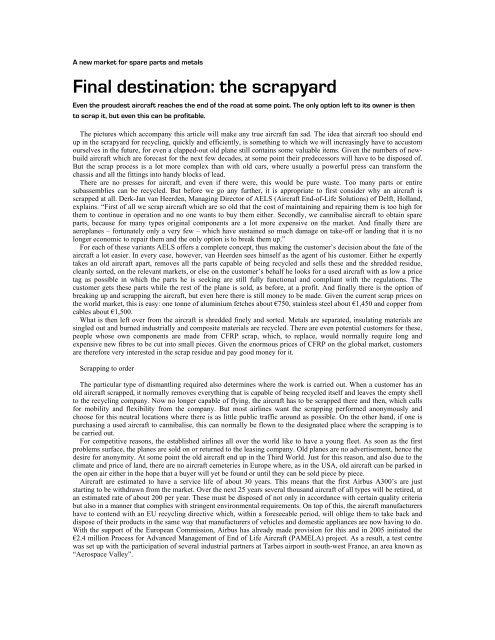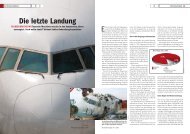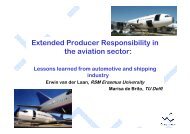Final destination: the scrapyard - AELS
Final destination: the scrapyard - AELS
Final destination: the scrapyard - AELS
Create successful ePaper yourself
Turn your PDF publications into a flip-book with our unique Google optimized e-Paper software.
A new market for spare parts and metals<br />
<strong>Final</strong> <strong>destination</strong>: <strong>the</strong> <strong>scrapyard</strong><br />
Even <strong>the</strong> proudest aircraft reaches <strong>the</strong> end of <strong>the</strong> road at some point. The only option left to its owner is <strong>the</strong>n<br />
to scrap it, but even this can be profitable.<br />
The pictures which accompany this article will make any true aircraft fan sad. The idea that aircraft too should end<br />
up in <strong>the</strong> <strong>scrapyard</strong> for recycling, quickly and efficiently, is something to which we will increasingly have to accustom<br />
ourselves in <strong>the</strong> future, for even a clapped-out old plane still contains some valuable items. Given <strong>the</strong> numbers of newbuild<br />
aircraft which are forecast for <strong>the</strong> next few decades, at some point <strong>the</strong>ir predecessors will have to be disposed of.<br />
But <strong>the</strong> scrap process is a lot more complex than with old cars, where usually a powerful press can transform <strong>the</strong><br />
chassis and all <strong>the</strong> fittings into handy blocks of lead.<br />
There are no presses for aircraft, and even if <strong>the</strong>re were, this would be pure waste. Too many parts or entire<br />
subassemblies can be recycled. But before we go any fur<strong>the</strong>r, it is appropriate to first consider why an aircraft is<br />
scrapped at all. Derk-Jan van Heerden, Managing Director of <strong>AELS</strong> (Aircraft End-of-Life Solutions) of Delft, Holland,<br />
explains. “First of all we scrap aircraft which are so old that <strong>the</strong> cost of maintaining and repairing <strong>the</strong>m is too high for<br />
<strong>the</strong>m to continue in operation and no one wants to buy <strong>the</strong>m ei<strong>the</strong>r. Secondly, we cannibalise aircraft to obtain spare<br />
parts, because for many types original components are a lot more expensive on <strong>the</strong> market. And finally <strong>the</strong>re are<br />
aeroplanes – fortunately only a very few – which have sustained so much damage on take-off or landing that it is no<br />
longer economic to repair <strong>the</strong>m and <strong>the</strong> only option is to break <strong>the</strong>m up.”<br />
For each of <strong>the</strong>se variants <strong>AELS</strong> offers a complete concept, thus making <strong>the</strong> customer’s decision about <strong>the</strong> fate of <strong>the</strong><br />
aircraft a lot easier. In every case, however, van Heerden sees himself as <strong>the</strong> agent of his customer. Ei<strong>the</strong>r he expertly<br />
takes an old aircraft apart, removes all <strong>the</strong> parts capable of being recycled and sells <strong>the</strong>se and <strong>the</strong> shredded residue,<br />
cleanly sorted, on <strong>the</strong> relevant markets, or else on <strong>the</strong> customer’s behalf he looks for a used aircraft with as low a price<br />
tag as possible in which <strong>the</strong> parts he is seeking are still fully functional and compliant with <strong>the</strong> regulations. The<br />
customer gets <strong>the</strong>se parts while <strong>the</strong> rest of <strong>the</strong> plane is sold, as before, at a profit. And finally <strong>the</strong>re is <strong>the</strong> option of<br />
breaking up and scrapping <strong>the</strong> aircraft, but even here <strong>the</strong>re is still money to be made. Given <strong>the</strong> current scrap prices on<br />
<strong>the</strong> world market, this is easy: one tonne of aluminium fetches about €750, stainless steel about €1,450 and copper from<br />
cables about €1,500.<br />
What is <strong>the</strong>n left over from <strong>the</strong> aircraft is shredded finely and sorted. Metals are separated, insulating materials are<br />
singled out and burned industrially and composite materials are recycled. There are even potential customers for <strong>the</strong>se,<br />
people whose own components are made from CFRP scrap, which, to replace, would normally require long and<br />
expensive new fibres to be cut into small pieces. Given <strong>the</strong> enormous prices of CFRP on <strong>the</strong> global market, customers<br />
are <strong>the</strong>refore very interested in <strong>the</strong> scrap residue and pay good money for it.<br />
Scrapping to order<br />
The particular type of dismantling required also determines where <strong>the</strong> work is carried out. When a customer has an<br />
old aircraft scrapped, it normally removes everything that is capable of being recycled itself and leaves <strong>the</strong> empty shell<br />
to <strong>the</strong> recycling company. Now no longer capable of flying, <strong>the</strong> aircraft has to be scrapped <strong>the</strong>re and <strong>the</strong>n, which calls<br />
for mobility and flexibility from <strong>the</strong> company. But most airlines want <strong>the</strong> scrapping performed anonymously and<br />
choose for this neutral locations where <strong>the</strong>re is as little public traffic around as possible. On <strong>the</strong> o<strong>the</strong>r hand, if one is<br />
purchasing a used aircraft to cannibalise, this can normally be flown to <strong>the</strong> designated place where <strong>the</strong> scrapping is to<br />
be carried out.<br />
For competitive reasons, <strong>the</strong> established airlines all over <strong>the</strong> world like to have a young fleet. As soon as <strong>the</strong> first<br />
problems surface, <strong>the</strong> planes are sold on or returned to <strong>the</strong> leasing company. Old planes are no advertisement, hence <strong>the</strong><br />
desire for anonymity. At some point <strong>the</strong> old aircraft end up in <strong>the</strong> Third World. Just for this reason, and also due to <strong>the</strong><br />
climate and price of land, <strong>the</strong>re are no aircraft cemeteries in Europe where, as in <strong>the</strong> USA, old aircraft can be parked in<br />
<strong>the</strong> open air ei<strong>the</strong>r in <strong>the</strong> hope that a buyer will yet be found or until <strong>the</strong>y can be sold piece by piece.<br />
Aircraft are estimated to have a service life of about 30 years. This means that <strong>the</strong> first Airbus A300’s are just<br />
starting to be withdrawn from <strong>the</strong> market. Over <strong>the</strong> next 25 years several thousand aircraft of all types will be retired, at<br />
an estimated rate of about 200 per year. These must be disposed of not only in accordance with certain quality criteria<br />
but also in a manner that complies with stringent environmental requirements. On top of this, <strong>the</strong> aircraft manufacturers<br />
have to contend with an EU recycling directive which, within a foreseeable period, will oblige <strong>the</strong>m to take back and<br />
dispose of <strong>the</strong>ir products in <strong>the</strong> same way that manufacturers of vehicles and domestic appliances are now having to do.<br />
With <strong>the</strong> support of <strong>the</strong> European Commission, Airbus has already made provision for this and in 2005 initiated <strong>the</strong><br />
€2.4 million Process for Advanced Management of End of Life Aircraft (PAMELA) project. As a result, a test centre<br />
was set up with <strong>the</strong> participation of several industrial partners at Tarbes airport in south-west France, an area known as<br />
“Aerospace Valley”.
Clean and environmentally neutral disposal is <strong>the</strong> objective<br />
The test centre, which has a workforce of about 100, is tasked with demonstrating that up to 95 percent of all <strong>the</strong><br />
components in a commercial aircraft can be recycled, reused or recovered. Moreover, Boeing is working on a similar<br />
project.<br />
The first project undertaken in Tarbes, over a period of 20 months, was to take apart an A300 which had been in<br />
service with a Turkish airline. The aim is that <strong>the</strong> experience gleaned from this scrapping exercise should flow into<br />
technologies for future projects, on which one would of course have to work a lot faster.<br />
Meanwhile <strong>the</strong> manufacturers are killing two birds with one stone with such projects. They are not only preparing<br />
<strong>the</strong>mselves for <strong>the</strong> possible take-back obligation, but disposal of <strong>the</strong> aircraft <strong>the</strong>y once built but which are now fit only<br />
for <strong>the</strong> <strong>scrapyard</strong> presents <strong>the</strong>m with <strong>the</strong> opportunity to generate a tidy sum <strong>the</strong>y had not been expecting. When <strong>the</strong><br />
cleanly separated extracted materials are sold, not only do <strong>the</strong> scrap prices mentioned above flow into <strong>the</strong> coffers, but<br />
good money can also be earned from recycling individual parts or entire subassemblies.<br />
Many parts still work perfectly well even after 30 years and could be reinstalled in new aircraft without any<br />
problems. O<strong>the</strong>rs only need an overhaul before landing on <strong>the</strong> spare parts market. The fact that <strong>the</strong> manufacturers<br />
<strong>the</strong>mselves are involved should ensure that customer trust is maintained, as <strong>the</strong> parts will be dismantled, overhauled<br />
and certified under stringent safety criteria. At <strong>the</strong> same time this action will ensure that <strong>the</strong> notorious “bogus parts”,<br />
that is, cheap, falsified spare parts which are by <strong>the</strong>ir nature a danger to flight safety, are withdrawn from <strong>the</strong> black<br />
market.<br />
Notwithstanding this, companies like <strong>the</strong> Dutch firm <strong>AELS</strong> will not lose out when <strong>the</strong> new system of scrapping<br />
aircraft comes into force. Smaller airlines especially which do not have huge capital resources up <strong>the</strong>ir sleeves will find<br />
it worth <strong>the</strong>ir while to call on <strong>the</strong> services of such companies. They will be able to have a special report prepared for<br />
every single aircraft in <strong>the</strong>ir fleet to help <strong>the</strong>m manage <strong>the</strong> costs. Sometimes it will still be worthwhile to park an<br />
aircraft in <strong>the</strong> desert and wait for a new purchaser, whereas with o<strong>the</strong>r aircraft this would be a waste of money. The<br />
specialists will <strong>the</strong>refore advise <strong>the</strong> owners about <strong>the</strong> current market for a given aircraft type, <strong>the</strong> actual value of <strong>the</strong><br />
intact aircraft and <strong>the</strong> value of all <strong>the</strong> extracted components, along with <strong>the</strong> costs of both conservation and scrapping.<br />
Every owner has to take leave of his aircraft at some point. It should at least be in good hands.<br />
MATTHIAS GRÜNDER






